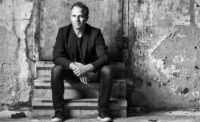Osaka, Japan, and Sydney
What’s in a name? For Facet Studio, the answer is: the firm’s philosophy. Whether in their Sydney or Osaka office, Facet’s directors, Olivia Shih, age 40, and Yoshihito Kashiwagi, 42, prioritize coming at a project from different angles to reveal the “gem,” or essence, of every project. “Once we find it,” says Kashiwagi, “we polish it and polish it until it becomes a diamond.”
Today, 90 percent of the diamonds in the rough are in Australia, where the firm has several projects in process, including a Japanese restaurant in Canberra, multiple buildings for a winery in Hunter Valley, a tiny shoe store in a Sydney shopping mall, plus residential projects. To accommodate their growing practice, the duo will move their four-person Sydney office from the city’s central business district to bigger digs in the ’burbs next June. In addition, their three-person office in Osaka keeps them poised to take on new work in Japan.
At the outset, the architects’ practice wasn’t quite so Australia-centric. Though the two met while working for Bates Smart, a corporate firm in Sydney, they came from different places. Born in Taipei, Taiwan, Shih moved to Australia at 13, while Kashiwagi grew up in Osaka, Japan. Because the fathers of both trained as architects, each was exposed to the building arts from a young age. The founder of a construction company, Shih’s father designed the family’s houses, engaging his daughter in the process even when she was in primary school. She also remembers visiting her father’s Sydney projects, which were supervised by her mother. “After school, we would go to the sites to see how they were coming along,” she remembers fondly. Kashiwagi has equally positive memories of his father’s career: “My father really enjoyed his work. He practiced architecture because he wanted to.”
Job satisfaction was part of the profession’s appeal for Kashiwagi. Though he attended architecture school in Tokyo, he had no intention of going overseas. But after seeing a Renzo Piano exhibition, he sought work with the Italian designer. Piano’s detail-oriented methodology influenced Kashiwagi’s design approach, and he liked working alongside people of many nationalities in the studio environment in Italy. Returning to Japan was no longer a given. Instead, he went to Australia.
The start of Shih and Kashiwagi’s own studio came about unexpectedly when the owner of a Thai take-out restaurant asked them to update her shop. Because she could not close during the day, the duo created the new components off-site and installed them at night. But Facet Studio’s practice really took off after winning the competition for the Doshisya Kyotanabe Chapel in Kyoto, an ambitious project accomplished partly by coaxing Kashiwagi’s father out of retirement to help them.
Today, Kashiwagi’s father continues to mind Facet’s Osaka shop. Yet nurturing practices in different countries can be challenging, admit Facet’s principals. What plays in Japan might not in Australia. Says Kashiwagi, “Japanese architecture is more experimental and probably would not be so acceptable here in Sydney.” But having access to different building practices is for Facet Studios the best of both worlds.
Facet Studio
FOUNDED: 2008
DESIGN STAFF: 4 (Sydney office), 3 (Osaka office)
PRINCIPALS: Olivia Shih and Yoshihito Kashiwagi
EDUCATION: Shih: University of New South Wales, B.Arch., 2000. Kashiwagi: Graduate School of Keio University, M.Arch., 1999; Keio University, Bachelor of Commerce, 1997
WORK HISTORY: Shih: Bates Smart, 2007–08; Nettleton Tribe, 2004–06; Francis-Jones Morehen Thorp, 2001–03. Kashiwagi: Bates Smart, 2008; Engelen Moore, 2000–07; Renzo Piano Building Workshop, 1999–2000
KEY COMPLETED PROJECTS: Doshisya Kyotanabe Chapel, Kyoto, Japan 2015; M House, Nigata, Japan, 2013; Higasa Lamp, 2013; Sneakerology, Sydney 2011
KEY CURRENT PROJECTS: Pokolbin House & Hunter Valley Cabin, 2018; Seatondale, Sydney, 2017; ExOD (Extraordinary Ordinary Day), 2017; Bellevue House, 2017









